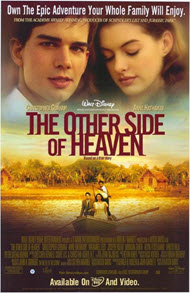The Other Side of Heaven
 for thematic elements and brief disturbing images.
for thematic elements and brief disturbing images.
Reviewed by: Ken James
CONTRIBUTOR
| Moral Rating: | Better than Average |
| Moviemaking Quality: |
|
| Primary Audience: | Teens Adults |
| Genre: | LDS Historical Drama |
| Length: | 1 hr. 53 min. |
| Year of Release: | 2001 |
| USA Release: |



With so many cults and denominations, how can I decide which are true and which are false?
What are the differences between Mormonism and Christianity, if any?
Should a Christian pray about the Book of Mormon to see if it is true?
More about Religion and Mormonism
Am I good enough to get to Heaven?
Recommend Christian Ministries helping those involved in Mormonism, or teaching Christians…
| Featuring |
|---|
| Christopher Gorham, Joe Folau, Anne Hathaway, Miriama Smith, John Sumner |
| Director |
|
Mitch Davis |
| Producer |
| Gerald R. Molen, John Garbett |
| Distributor |
| Excel Entertainment Group, Inc. |
There are so many real-life missionary stories out there that are full of suspense, mystery, intrigue, action, and drama. Hundreds, if not thousands of faith-based films could be created to merely scratch the surface of what has been happening around the world in the past few centuries. (See From Jerusalem to Irian Jaya for a good compilation of such stories).
“The Other Side of Heaven” is one such story, but specifically focused on the propagation of the false Mormon doctrines brought forth by Joseph Smith, Brigham Young, and others since the 19th century. This true-life story, based on the experiences of Idaho native John Groberg (played by Christopher Gorham), has our young “Elder Groberg” heading from home to the isolated islands of the Tongan nation during the 1950s. He leaves behind his one true love, Jean (Anne Hathaway of “The Princess Diaries”), whom he hopes to marry upon his return from his mission, creating the union that the LDS church believes will last into all eternity. Yet Jean also has another suitor—will she be able to wait three years until John returns from his missionary stint on a faraway tropical island? This is just one of the many complexities John must deal with.
I’ve spent time in Asia as a missionary (though not LDS) and can say that this story is very true to life: facing suspicion from the locals, having to learn an entirely new language and culture, drastically changing one’s diet, all while trying to share a gospel that you believe to be the only true faith. Like every other “Elder” I’ve met (the LDS term for their missionaries), John is very personable, honest, hard-working, and sincere about his faith and eager to share it with others.
As history shows, the Tongan islands show an amazing percentage of the population adherent to the Mormon faith. If you’re not a geography buff, the Tongan islands are situated in the Pacific about 2/3 of the way between Hawaii and New Zealand. It is a monarchy with just over 100,000 people. While the Protestant faith has also been brought to these islands, the Tongan people seems be to especially open to aberrant teachings like Mormonism and Jehovah’s Witnesses. The tiny island that John found himself on is no exception: the people were already familiar with Protestant Christianity, even having its own minister, and so were wary of the LDS faith. Yet many of these Tongans see John’s good life and, like John’s Tongan companion (another Elder who goes from family to family sharing the LDS teachings), believe that what John teaches must be true since he came so far to share it. He wouldn’t have done that if it was a lie, would he? Interesting logic. One can still be sincere, but sincerely wrong.
During his time on the island, John faces both good times and bad times. The Protestant minister and several others believe the gospel John teaches is false and will therefore have nothing to do with him. He is often shunned, but over time even the minister comes to realize he just did not know John. The two make peace, leaving the viewer to feel that justice has now been served. In another scene, a strong stance for sexual abstinence comes through loud and clear (kudos to that) as a stunningly beautiful local girl literally throws herself at this innocent American man. Rebuffed by him sexually, she goes on to later accept the LDS teachings too. In an early scene, a father brings John his dead son, firmly believing that he has the power to raise him from the dead. Not knowing what to do, John takes the boy in and spends over 24 hours in prayer for him. Reciting a strange mantra of “Good air in, bad air out,” the boy is revived. Was it God that gave him back his life? I had difficulty knowing what to make of that scene, though I do believe God has the power to raise anyone He wishes from the dead. Naturally, when this happens many locals come to believe in the power of the Mormon faith.
John continues to face other hardships, from the dangerous high seas to hurricanes on a destructive rampage. Every time, he is shown as truly caring and eager to help anyone he can. Despite the strong character and positive morality taught throughout “The Other Side of Heaven”, I cannot recommend it for others. While Director Mitch Davis and Producers Gerald R. Molen and John Garbett are to be applauded for making a technically strong faith-based film with a compelling story (though 45 minutes should have been cut out), we cannot support a film that promotes the LDS church or its teachings in any way.
The official film site for “The Other Side of Heaven” states that this film “is only a Mormon movie in the sense that the main character in the film is a member of the Church of Jesus Christ of Latter-day Saints. The film was not produced, funded or endorsed in any way by that Church. However, because John Groberg is a current leader in the Church, he did consult with the leadership before allowing his life’s story to be told. His leaders raised no objections.” But film production company Excel Entertainment lets it be known that “Excel Entertainment is dedicated to serving the LDS entertainment market through music, films, and other media. Our goal is to produce art and entertainment that reflects our beliefs and initiates thought-provoking dialogue.” That it certainly does in “The Other Side of Heaven”. It is propagandic in nature, and could be spiritually dangerous to those who are open to considering the teachings of the Church of Jesus Christ of Latter-Day Saints.
To learn more from a biblical Christian perspective on what the LDS church teaches, please see our section on Mormon teachings. For biblical Christian materials in Tongan, please visit our Tongan homepage.


[Excellent! / 5]
[Excellent! / 5]
[Good / 3½]
[Excellent! / 5]
[Excellent! / 4]
[Very Offensive / 2½]
[Very Offensive / 2½]
[Good / 4½]
[Excellent! / 5]
[Excellent! / 4]
As far as the critics go, I’ve found they generally fall into two categories. There are the people who object to characters with Christian values, (the extreme ones just plain don’t like Mormons no matter what film they’re in) and the people bothered by its lack of over-the-top conflict in the main character. Regular Joes aren’t “realistic” or “believable” I guess, that is, if you consider someone who is lost at sea for three months, has their feet eaten by rats and faces all the daunting challenges that John Groberg does to be bland. If you’re open minded enough to view a film with religious people in it without starting a holy war there in the theater, you’ll be able to appreciate this movie. It’s a good solid film that was great entertainment. I highly recommend it.
[Excellent! / 4]
And, also, something that really bothered me was in the part where the missionary brings to life a kid that was dead. First, He didn’t even pray for him, he just said: “bad air out, good air in” what’s that!?!?! (spooky) Second, He never mentions God or Jesus, so if that was his “prayer,” to whom was he praying??? So if he wasn’t praying to God, then to whom? Definitely, God was not involved in that, because he was not even invited, so my question is: Who did that “miracle”? I have my own answer, but I don’t want to offend anybody here, I’ll leave it like that… but think deeply about it… And who gets the credit for that?
[Better than Average / 3]
The Christian church on the island is portrayed as evil and unaccepting of the missionary, until the end when the pastor suddenly “comes to his senses.” I strongly do not recommend this movie.
[Very Offensive / 1½]
My Ratings: [Good / 5]